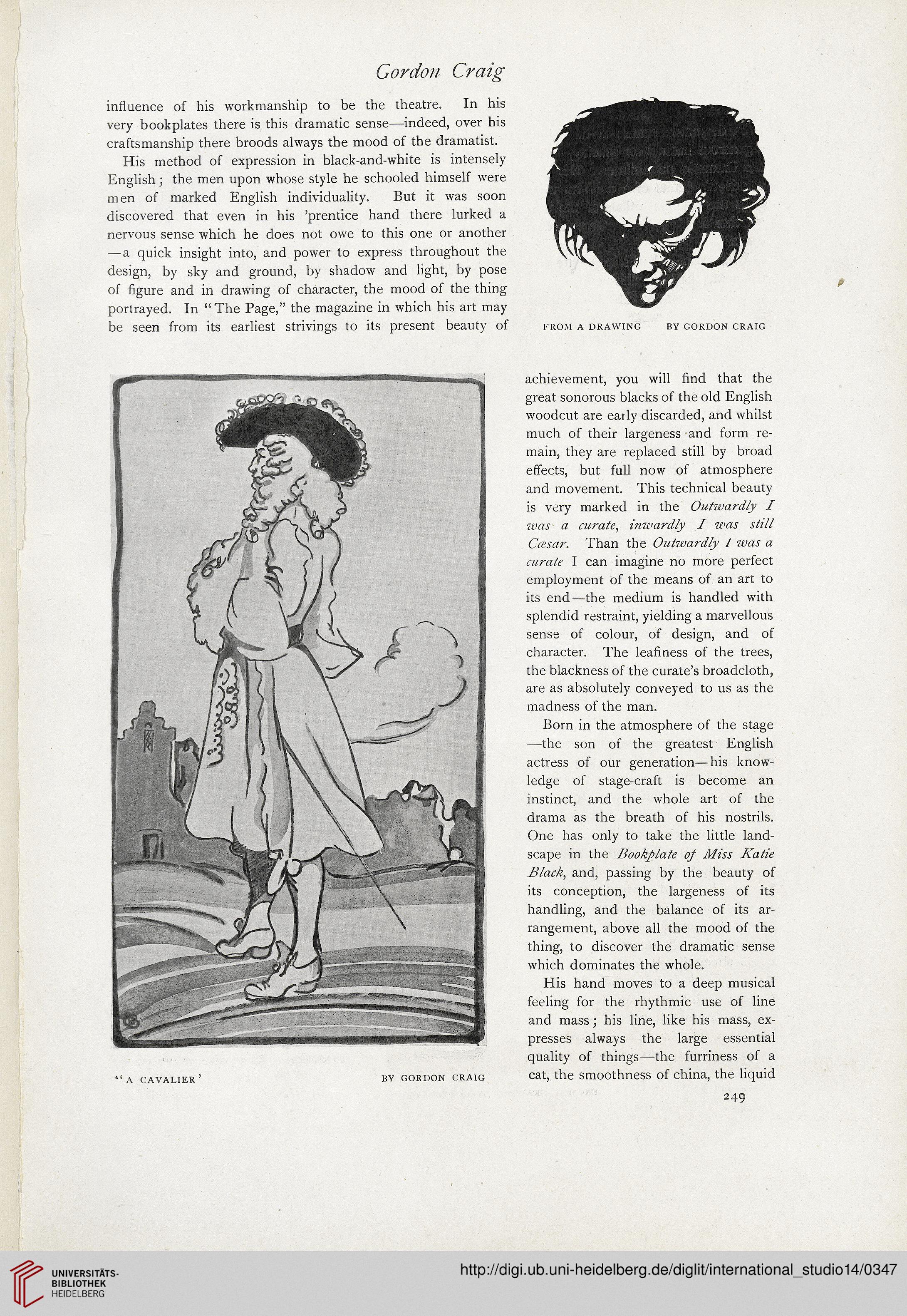Gordon Craig
influence of his workmanship to be the theatre. In his
very bookplates there is this dramatic sense—indeed, over his
craftsmanship there broods always the mood of the dramatist.
His method of expression in black-and-white is intensely
English; the men upon whose style he schooled himself were
men of marked English individuality. But it was soon
discovered that even in his ’prentice hand there lurked a
nervous sense which he does not owe to this one or another
—a quick insight into, and power to express throughout the
design, by sky and ground, by shadow and light, by pose
of figure and in drawing of character, the mood of the thing
portrayed. In “ The Page,” the magazine in which his art may
be seen from its earliest strivings to its present beauty of
FROM A DRAWING BY GORDON CRAIG
■“A CAVALIER’
BY GORDON CRAIG
achievement, you will find that the
great sonorous blacks of the old English
woodcut are early discarded, and whilst
much of their largeness and form re-
main, they are replaced still by broad
effects, but full now of atmosphere
and movement. This technical beauty
is very marked in the Outivardly I
was a curate, inwardly I was still
Ccesar. Than the Outwardly l was a
curate I can imagine no more perfect
employment of the means of an art to
its end—the medium is handled with
splendid restraint, yielding a marvellous
sense of colour, of design, and of
character. The leafiness of the trees,
the blackness of the curate’s broadcloth,
are as absolutely conveyed to us as the
madness of the man.
Born in the atmosphere of the stage
—the son of the greatest English
actress of our generation—his know-
ledge of stage-craft is become an
instinct, and the whole art of the
drama as the breath of his nostrils.
One has only to take the little land-
scape in the Bookplate op Miss Katie
Black, and, passing by the beauty of
its conception, the largeness of its
handling, and the balance of its ar-
rangement, above all the mood of the
thing, to discover the dramatic sense
which dominates the whole.
His hand moves to a deep musical
feeling for the rhythmic use of line
and mass; his line, like his mass, ex-
presses always the large essential
quality of things—the furriness of a
cat, the smoothness of china, the liquid
249
influence of his workmanship to be the theatre. In his
very bookplates there is this dramatic sense—indeed, over his
craftsmanship there broods always the mood of the dramatist.
His method of expression in black-and-white is intensely
English; the men upon whose style he schooled himself were
men of marked English individuality. But it was soon
discovered that even in his ’prentice hand there lurked a
nervous sense which he does not owe to this one or another
—a quick insight into, and power to express throughout the
design, by sky and ground, by shadow and light, by pose
of figure and in drawing of character, the mood of the thing
portrayed. In “ The Page,” the magazine in which his art may
be seen from its earliest strivings to its present beauty of
FROM A DRAWING BY GORDON CRAIG
■“A CAVALIER’
BY GORDON CRAIG
achievement, you will find that the
great sonorous blacks of the old English
woodcut are early discarded, and whilst
much of their largeness and form re-
main, they are replaced still by broad
effects, but full now of atmosphere
and movement. This technical beauty
is very marked in the Outivardly I
was a curate, inwardly I was still
Ccesar. Than the Outwardly l was a
curate I can imagine no more perfect
employment of the means of an art to
its end—the medium is handled with
splendid restraint, yielding a marvellous
sense of colour, of design, and of
character. The leafiness of the trees,
the blackness of the curate’s broadcloth,
are as absolutely conveyed to us as the
madness of the man.
Born in the atmosphere of the stage
—the son of the greatest English
actress of our generation—his know-
ledge of stage-craft is become an
instinct, and the whole art of the
drama as the breath of his nostrils.
One has only to take the little land-
scape in the Bookplate op Miss Katie
Black, and, passing by the beauty of
its conception, the largeness of its
handling, and the balance of its ar-
rangement, above all the mood of the
thing, to discover the dramatic sense
which dominates the whole.
His hand moves to a deep musical
feeling for the rhythmic use of line
and mass; his line, like his mass, ex-
presses always the large essential
quality of things—the furriness of a
cat, the smoothness of china, the liquid
249




